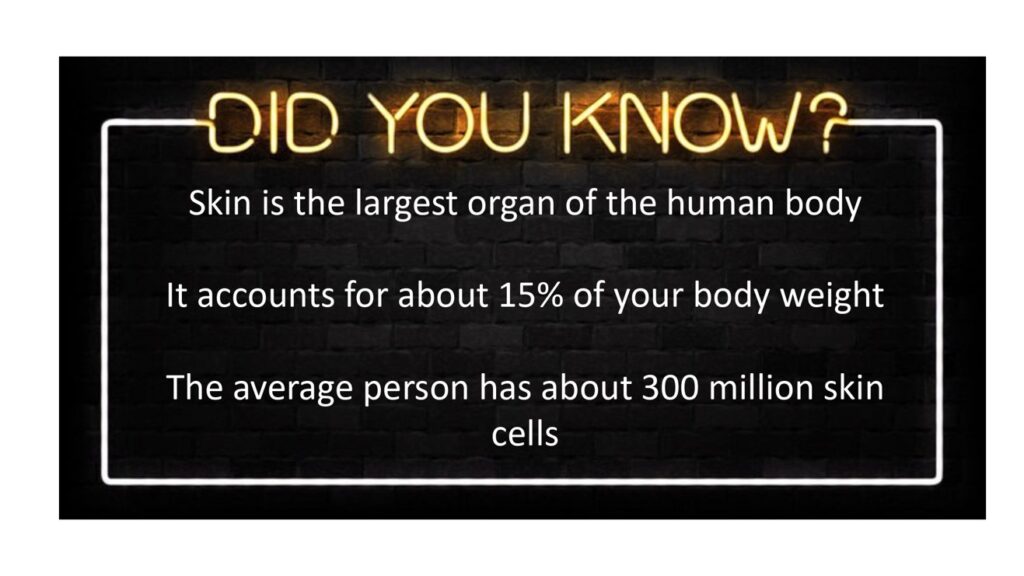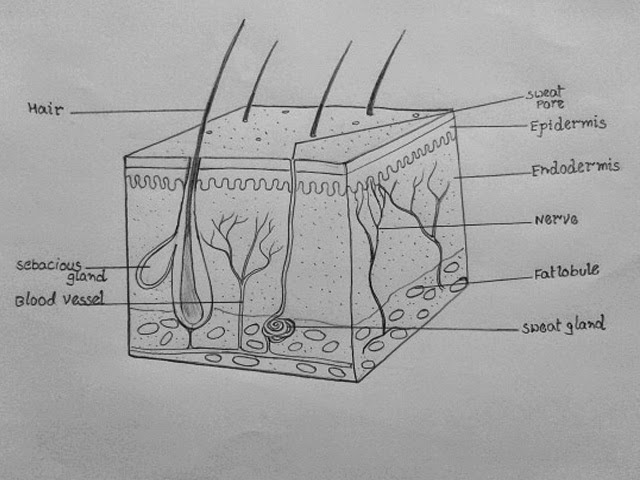STEAM PROJECT
Topic: What happens to tissue after an injury, explain the tissue healing process in detail.
Objective: Describe tissues in the integumentary system and their functions.
The integumentary system is the largest organ of the human body. The components of the integumentary system are:
- Skin
- Hair
- Nails
- Glands
The skin along with its appendages makes up an anatomic boundary and a physical barrier between the body’s external and internal environment.

Skin has 2 layers:
- Epidermis (superficial layer): It is a thin outer layer of stratified squamous epithelial tissue. It acts as the first line of defense against the external environment.
- Dermis (deeper layer): It is the thick underlying layer. It is mainly composed of connective tissue. This framework of connective tissue supports the epidermis.

Beneath the skin is hypodermis which is a layer of loose connective tissue. It also contains adipose tissue. The hypodermis layer is also known as subcutaneous tissue. It provides additional support and connects the skin to underlying structures.
Hair is derived from the epidermis, but its roots are found deep down in the dermis known as the hair follicle. The sebum is released in the hair follicle to lubricate the hair.
Nails are a sheet of complex keratinized cells. They appear on the dorsal tips of fingers and toes.
Skin also contains glands like sweat and sebaceous glands. Sweat glands play a role in the modification of body temperature. Sebaceous glands secrete an oily substance known as sebum which lubricates the skin and hair.
Functions of Integumentary System:
Along with acting as a physical barrier, the integumentary system is also responsible for maintaining an optimal internal environment for vital components of the body to survive. The integumentary system has several functions like physical protection, thermoregulation, and vitamin D synthesis. Skin is also capable of detecting and discriminating between sensations like pain, touch, temperature, and vibration due to various sensory nerve endings.
Skin is the first line of defense in our body’s defense system. Being exposed to the external environment is prone to wounds, infections, burns, etc.
The integumentary system is a fascinating system because it is capable of providing clues in cases of underlying pathologies. For example, the skin will show yellowish discoloration in case of liver dysfunction. Dehydration can manifest as decreased skin turgor.
Wound healing:
Skin is exposed to the external environment, and it is very susceptible to injuries. When our body undergoes trauma that results in an injury, the integumentary system comes into play and is responsible for repairing this insult through a series of complex steps that ultimately result in the resolution of the wound.
The human body is capable of healing the wound in the following four stages:
- Hemostasis: When you get a cut or an injury that results in a wound it usually starts bleeding. The first step is to stop bleeding. Hemostasis means blood halting. Blood begins to a clot that stops the bleeding.
- Inflammation: In this stage, immune cells enter the wound site to attack pathogens and clear out debris. There is localized swelling in this stage. This localized inflammation prevents infection and controls bleeding.
- Proliferation: After the wound has been stabilized in the above two stages. The body begins to rebuild the injured site. This stage is mainly responsible for angiogenesis and granulation tissue formation. The new tissue formed at the injured site is made up of collagen and extracellular matrix. Angiogenesis is the formation of new blood vessels; this is necessary so that the new tissue is healthy and is receiving adequate nutrients and oxygen.
- Remodeling or Maturation Phase: In this stage, the body attempts to restore the original architecture of the skin. There is apoptosis in which unwanted cells are removed from the area of focus and the body continues to repair and strengthen that area.

Sources:
- Rodrigues, M., Kosaric, N., Bonham, C. A., & Gurtner, G. C. (2019, January 1). Wound healing: A cellular perspective. Physiological reviews. Retrieved July 22, 2022, from https://www.ncbi.nlm.nih.gov/pmc/articles/PMC6442927/
- Physiology, integument – statpearls – NCBI bookshelf. (n.d.). Retrieved July 21, 2022, from https://www.ncbi.nlm.nih.gov/books/NBK554386/
- Mauldin, E. A., & Peters-Kennedy, J. (2016). Integumentary system. Jubb, Kennedy & Palmer’s Pathology of Domestic Animals: Volume 1. Retrieved July 22, 2022, from https://www.ncbi.nlm.nih.gov/pmc/articles/PMC7810815/
- Iftikhar, N. (2019, December 19). Stages of wound healing: 4 stages and what to expect. Healthline. Retrieved July 22, 2022, from https://www.healthline.com/health/skin/stages-of-wound-healing#healing-time
